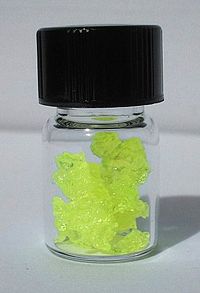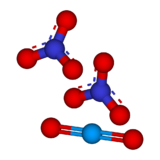- Uranyl nitrate
-
Uranyl nitrate 
 (T-4)-bis(nitrato-κO)dioxouraniumOther namesUranium nitrate
(T-4)-bis(nitrato-κO)dioxouraniumOther namesUranium nitrateIdentifiers CAS number 10102-06-4 
ChemSpider 22177973 
Jmol-3D images Image 1 - [N+](=O)([O-])O[U-2](=O)(=O)O[N+](=O)[O-]
Properties Molecular formula UO2(NO3)2 Molar mass 394.04 g/mol Appearance yellow-green solid
hygroscopicDensity 2.81 g/cm3 Melting point 60 °C
Boiling point 118 °C decomp.
Solubility in water ~660 g/L Solubility in tributyl phosphate soluble Hazards MSDS External MSDS EU Index 092-002-00-3 EU classification Very toxic (T+)
Dangerous for the environment (N)R-phrases R26/28, R33, R51/53 S-phrases (S1/2), S20/21, S45, S61 Flash point Non-flammable Related compounds Other anions Uranyl chloride
Uranyl sulfate nitrate (verify) (what is:
nitrate (verify) (what is:  /
/ ?)
?)
Except where noted otherwise, data are given for materials in their standard state (at 25 °C, 100 kPa)Infobox references Uranyl nitrate (U O2(N O3)2) is a water soluble yellow uranium salt. The yellow-green[1] crystals of uranium nitrate hexahydrate are triboluminescent.
Uranyl nitrate can be prepared by reaction of uranium salts with nitric acid. It is soluble in water, ethanol, acetone, and ether, but not in benzene, toluene, or chloroform.
Contents
Uses
During the first half of the 19th century, many photosensitive metal salts had been identified as candidates for photographic processes, among them uranyl nitrate. The prints thus produced were alternately referred to as uranium prints, urbanities, or more commonly uranotypes. The first uranium printing processes were invented by a Scotsman, J. Charles Burnett, between 1855 and 1857, and used this compound as the sensitive salt. Burnett, authored an 1858 article comparing "Printing by the Salts of the Uranic and Ferric Oxides" The basis for the process lies in the ability of the uranyl ion to pick up two electrons and reduce to the lower oxidation state of uranium(IV) under ultraviolet light. Uranotypes can vary from print to print from a more neutral, brown russet to strong Bartolozzi red, with a very long tone grade. Surviving prints are slightly radioactive, a property which serves as a means of non-destructively identifying them. Several other more elaborate photographic processes employing the compound sprung up and vanished throughout the second half of the century with names like Wothlytype, Mercuro-Uranotype and the Auro-Uranium process. Uranium papers were manufactured commercially at least until the end of the 19th century, vanishing in the face of the superior sensitivity and practical advantages of the silver halides. Nevertheless between the 1930s through the 1950s Kodak Books still described a uranium toner (Kodak T-9) using uranium nitrate hexahydrate. Some alternative process photographers including artists Blake Ferris & Robert Schramm continue to make uranotype prints today.
Along with uranyl acetate it is used as a negative stain for viruses in electron microscopy; in tissue samples it stabilizes nucleic acids and cell membranes.
Uranyl nitrate was used to fuel Aqueous Homogeneous Reactors in the 1950s. However it proved too corrosive in this application, and the experiments were abandoned.
Uranyl nitrate is important for nuclear reprocessing; it is the compound of uranium that results from dissolving the decladded spent nuclear fuel rods or yellowcake in nitric acid, for further separation and preparation of uranium hexafluoride for isotope separation for preparing of enriched uranium.
Health and environmental issues
Uranyl nitrate is an oxidizing and highly toxic compound and should not be ingested; it causes severe renal insufficiency and acute tubular necrosis and is a lymphocyte mitogen. Target organs include the kidneys, liver, lungs and brain. It also represents a severe fire and explosion risk when heated or subjected to shock in contact with oxidizable substances.
External links
- URANIUM DAYS: Notes On Uranium Photography (2007 archive from archive.org)
- Chemical Database – Uranyl nitrate, solid
References
- ^ Roberts, D.E. and Modise, T.S. (2007). Laser removal of loose uranium compound contamination from metal surfaces. Applied Surface Science 253, 5258–5267.
Uranium compounds (NH4)2U2O7 · Na2O(UO3)2 · Na2U2O7 · UB2 · U(BH4)4 · UCl3 · UCl4 · UF4 · UF5 · UF6 · UH3 · UO2 · UO3 · UO4 · U3O8 · UO2(CH3COO)2 · UO2(CHO2)2 · UO2CO3 · UO2CO3·2(NH4)2CO3 · UO2Cl2 · UO2F2 · UO2(NO3)2 · UO2(OH)2 · UO2(SO4)2 · U(S04)2 · ZnUO2(CH3COO)4
Categories:- Uranyl compounds
- Nitrates
- Nuclear materials
- Electron microscopy stains
- Photographic chemicals
- Oxidizing agents
Wikimedia Foundation. 2010.
